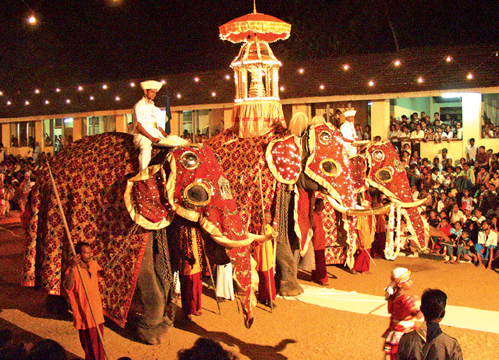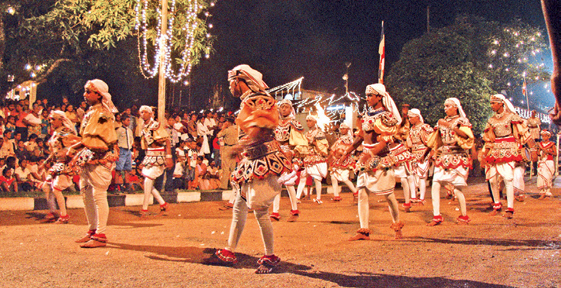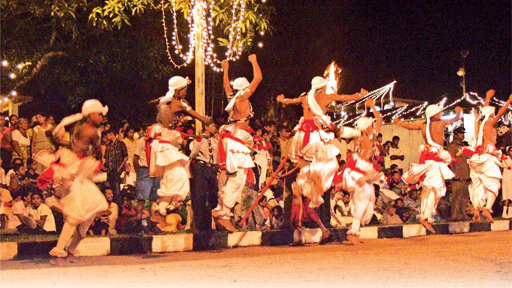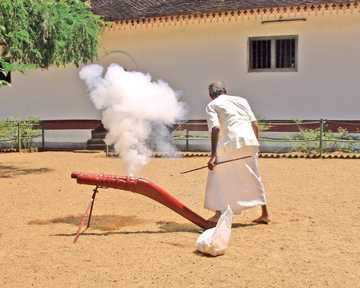Ancient and spectacular
Maha Saman Devale Perahera celebrating God Sumana
Saman:
Story and pictures by Mahil Wijesinghe
 It is a clear evening, with even the weather gods looking down
benevolently, holding the thundershowers at bay, as the annual perahera,
the age-old ritual of celebrating God Sumana Saman, gets underway. It is a clear evening, with even the weather gods looking down
benevolently, holding the thundershowers at bay, as the annual perahera,
the age-old ritual of celebrating God Sumana Saman, gets underway.
A much looked forward to event for the people of Sabaragamuwa, the
evening sees men, women and children thronging Ratnapura's Sabaragamuwa
Maha Saman Devale for ringside seats as the perahera winds its way
around the Devale premises.
As darkness engulfs the area and drumbeats resonate everywhere, the
Devale and its surroundings take on a carnival atmosphere with thousands
of colourful bulbs strung from treetops to rooftops lighting up the
area.
For five days in the third week of rainy September, the premises of
the Maha Saman Devale get magically transformed by the ancient pageantry
of the spectacular Saman Devale Perahera. This year's perahera got
underway on September 23 and will continue till September 28.
|

Many dance forms add rich variety to the perahera |
 |
The
annual perahera is a colourful devotional display that honours God
Sumana Saman who is believed to be the guardian deity of Sri Pada or
Adam's peak. The perahera is a tradition that goes back many centuries
and is considered second only to the Esala Perahera in Kandy.
The perahera showcases the observance of age-old customs and rituals
dedicated to God Sumana Saman and portray certain aspects of the Sinhala
Buddhist culture, interwoven with the performing arts of the province
that is strongly influenced by certain aspects of the folk religion of
the Sabaragamuwa Province.
The perahera, overseen by the chief custodian of the Devale, the
Basnayake Nilame is unique in its combination of local performing arts
traditions including the upcountry (Kandyan) low country (Southern) and
its own Sabaragamuwa regions- with dance.
The perahera has also given a platform to certain art forms, which
were on the wane, owning to the lack of an appreciative audience and
vanishing generations.
The pageant begins after the 'Kap Sitawima' ceremony at an auspicious
time, which in keeping more with traditions than rituals, is announced
by firing the Portuguese muzzle loaded cannon in what is known as 'Peramune
Rajakariya'. This duty is passed from person to person each year.
Auspicious time
|

The impressive Mahabamba Kolama at the perahera |
Before
the perahera begins, the person who is in charge of 'Peramune Rajakariya'
starts to clean the cannon, which is a remnant of the Portuguese period
and is placed in a well-protected room in the Devale for the year.
Those watching the perahera, especially children, are mesmerized by
the 'Mahabamba Kolama', an inherited feature in Sabaragamuwa and can
only be seen at the Saman Devale Perahera. The huge, around 15 -foot
high, colourfully dressed, two faced figure of Mahabamba, with a serene
face on one side and a fierce demonic one on the other, is a remarkable
feature at this Perahera. Legend has it that the huge figure depicts the
character of King Rajasingha I.
Creating Mahabamba for perahera each year is also a duty of the two
persons slated for 'Peramune Rajakariya'. Every year, a few days prior
to commencing the perahera, the pair who are in charge of Mahabamba,
start making the structure by first creating a bamboo skeleton of the
body and hands. They then fix the mask onto the skeleton and dress it in
colourful cloths.
The energetic between the two become the Mahabamba, donning on the
frame, walking and rotating it each night of the perahera, while his
companion walks alongside, instructing him about what to do and where to
go.
|

Firing the Portuguese muzzle loading cannon at the
auspicious time. |
As the perahera readies for the parade, a beautifully ornamented
relic casket and a gem-studded relic chamber are reverently placed upon
the majestic tusker, especially chosen for the occasion, amidst a
crescendo of conches, flutes and drums.
Special attendants lay white carpets along the path of the tusker, as
it regally leads the way. And the people watching the spectacle bow
their heads in reverence. The tusker is followed by many similarly
caparisoned elephants.
Preceding and interspersed between the elephants are torch-bearers,
acrobats, dancers, fire-ring twirlers stilt walkers and Hewisi drummers
swaying to the beat of the Geta Bera. Adding to the glamour, a variety
of dance forms of the low country, among them Kolam and Gini Sisila and
Vadige Patuna, which is distinctive to Sabaragamuwa that enthral the
crowd.
Another impressive repertoire of drums, including the Daula of the
Sabaragamuwa Province, the Yak Bera of the South can also be seen in the
perahera.
Traditional art forms
|

Exterior view of the Maha Saman Dewale at Ratnapura |
The performing artistes are from guilds specializing in the various
dance forms passed on from generation to generation, and their
performances are of a high standard. One can witness several types of
traditional art forms at this perahera.
The entire Devale premises is packed with people and the excitement
grows as the dancers take turns to swirl and twirl and bring the whole
area alive with sounds and twirling colours. More elephants join the
drum beats echo and more people join to view the perahera.
The culmination of the perahera is the water-cutting ceremony on the
last day at Ratabala Ella in Kalu Ganga, followed by the day perahera.
On the night following the completion of the perahera, a ritual is
performed to bless all those who participated in the perahera, including
Basnayake Nilame, Kapuralas, dancers, drummers and the elephants.
The three - storeyed Maha Saman Devale of Ratnapura stands majestic
on a hillock on the bank of the Kalu Ganga. According to historical
records, it had been built by Arya Kamadeva, a minister of the courts of
King Parakramabahu II, in honour of the God Saman in fulfilment of a vow
made by him before commencing gem mining.
Subsequently, Rajasingha I of Sitawaka had restored the Devale. In
the stone built ramparts in front of the Devale there is a plaque
depicting two warriors standing in symbolic form. The destruction caused
to the Devale by the Portuguese is depicted by the plaque.
(The images are from last year's perahera)
|

